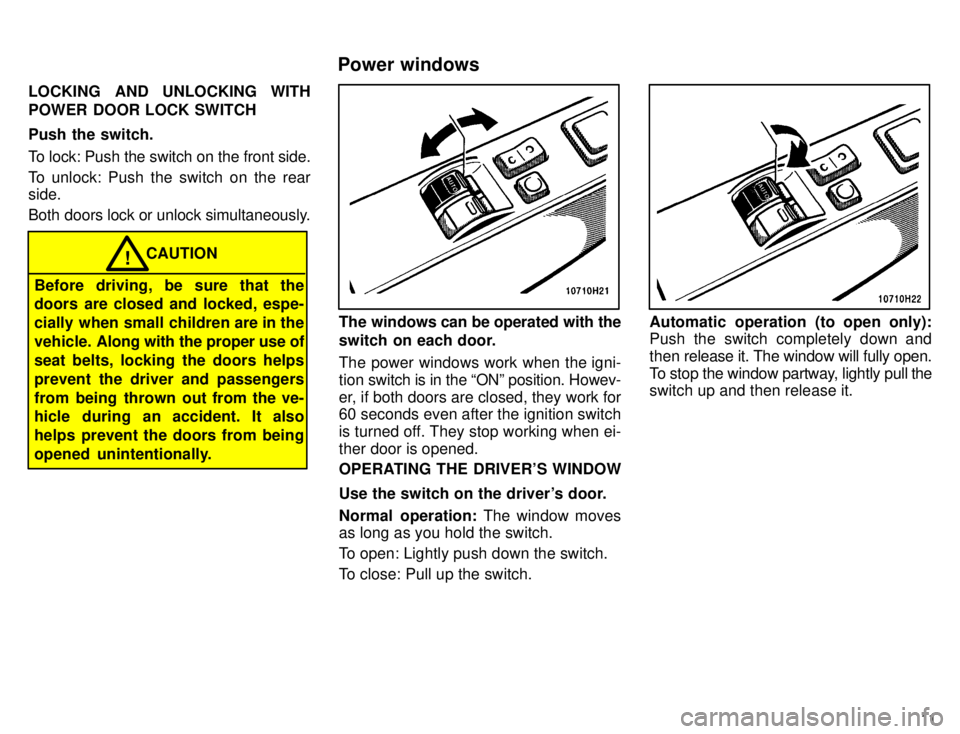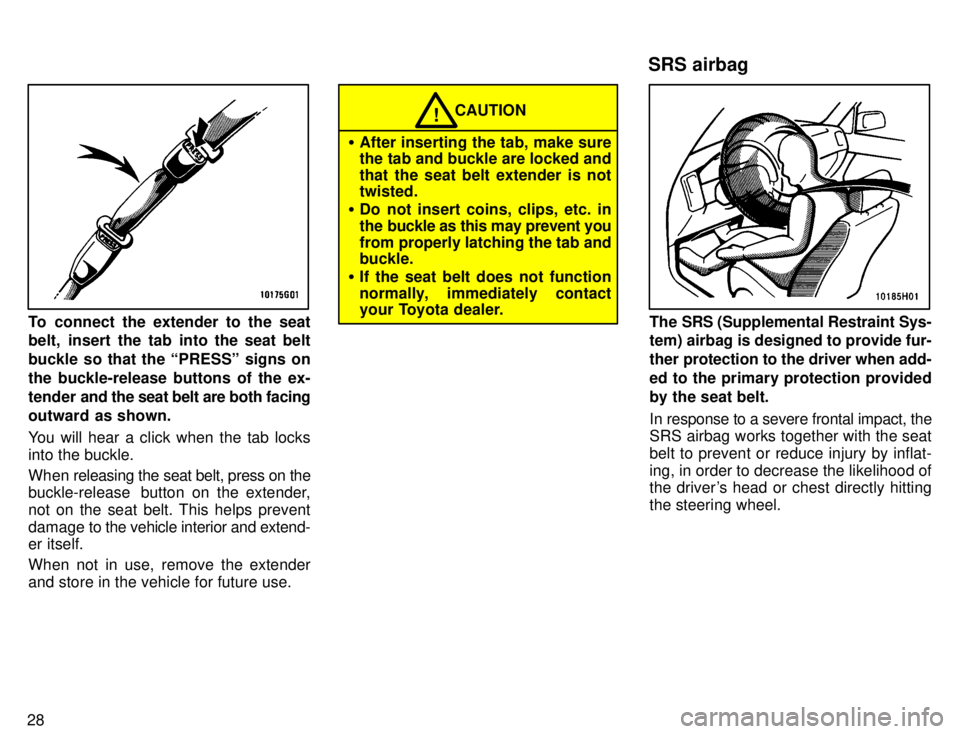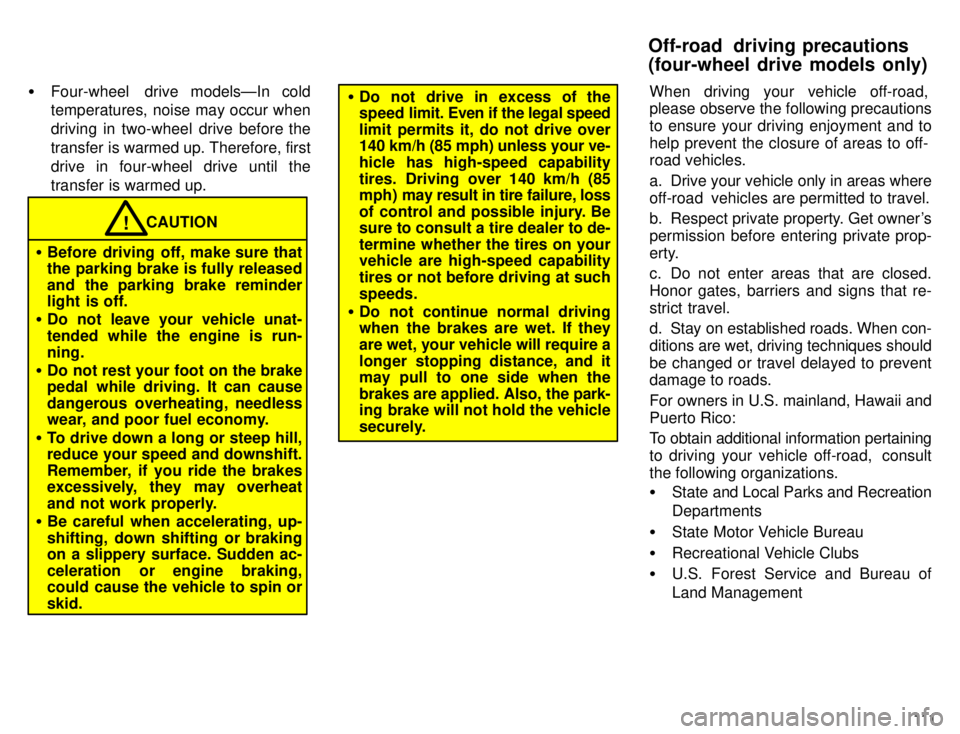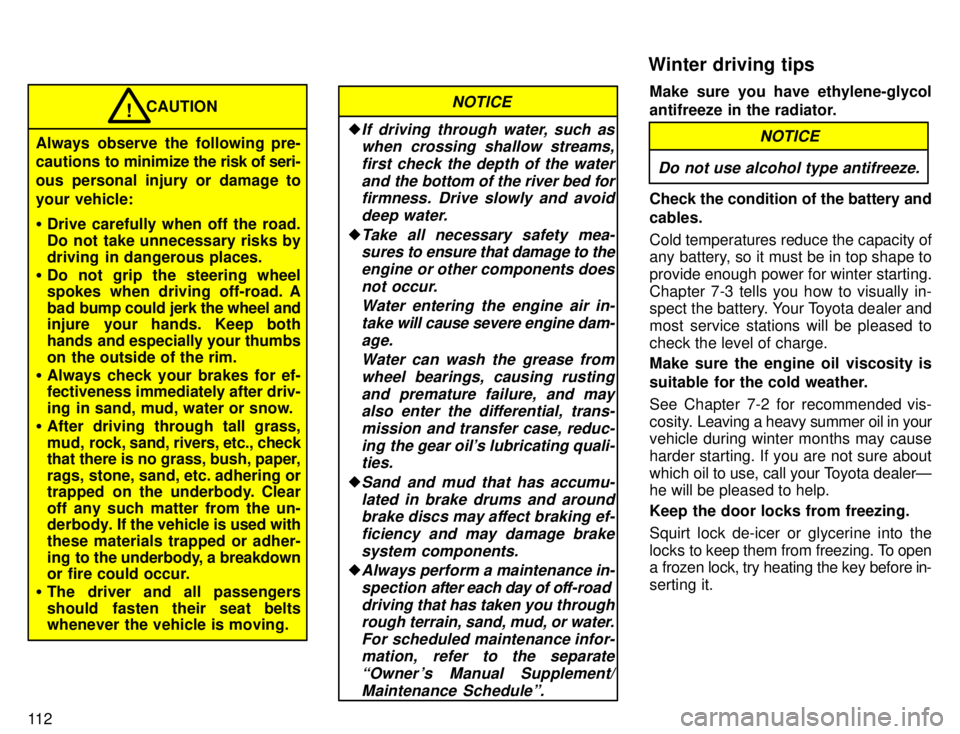1996 TOYOTA TACOMA ESP
[x] Cancel search: ESPPage 12 of 196

11
LOCKING AND UNLOCKING WITH
POWER DOOR LOCK SWITCH Push the switch.
To lock: Push the switch on the front side.
To unlock: Push the switch on the rear side.
Both doors lock or unlock simultaneously.
CAUTION!
Before driving, be sure that the
doors are closed and locked, espe-
cially when small children are in the
vehicle. A long with the proper use of
seat belts, locking the doors helps
prevent the driver and passengers
from being thrown out from the ve-
hicle during an accident. It also
helps prevent the doors from being
opened unintentionally.
The windows can be operated with the
switch on each door.
The power windows work when the igni- tion switch is in the ONº position. Howev-
er, if both doors are closed, they work for 60 seconds even after the ignition switch
is turned off. They stop working when ei-ther door is opened.
OPERATING THE DRIVER'S WINDOW
Use the switch on the driver's door.
Normal operation: The window moves
as long as you hold the switch.
To open: Lightly push down the switch.
To close: Pull up the switch.Automatic operation (to open only):
Push the switch completely down and
then rel ease it. The window will fully open.
To stop the window partway, lightly pull the
switch up and then release it.
Power windows
Page 13 of 196

12
OPERATING THE PASSENGERS' WIN-
DOW
Use the switch on the passenger's
door or the switch on the driver's door
that controls the passenger's window.
The window moves as long as you hold the switch.
To open: Push down the switch.
To close: Pull up the switch.
If you push in the WINDOW LOCKº but-
ton on the driver's door, the passenger'swindows cannot be operated.
CAUTION!
To avoid serious personal injury, you
must do the following. � Always make sure the head, hands
and other parts of the body of all oc-
cupants are kept completely inside
the vehicle before you close the
power windows. If someone's n eck,
head or hands gets caught in a clos-
ing window, it could result in a seri-
ous injury. When anyone closes the
power windows, be sure that they
operate the windows safely.
� When small children are in the ve-
hicle, never let them use the power
window switches without supervi-
sion. Use the WINDOW LOCKº
button to prevent them from mak-
ing unexpected use of theswitches.
� Never leave small children alone in
the vehicle, especially with the igni-
tion key still inserted. They could
use the power window switches
and get trapped in a window. Unat-
tended children can become in-
volved in serious accidents.
Page 30 of 196

28
To connect the extender to the seat
belt, insert the tab into the seat belt
buckle so that the PRESSº signs onthe buckle-release buttons of the ex-
tender and the seat belt are both facing
outward as shown.
You will hear a click when the tab locks into the buckle.
When releasing the seat belt, press on the
buckle-release button on the extender, not on the seat belt. This helps prevent
damage to the vehicle interior and extend- er itself.
When not in use, remove the extender
and store in the vehicle for future use.
CAUTION!
� After inserting the tab, make sure
the tab and buckle are locked and
that the seat belt extender is not twisted.
� Do not insert coins, clips, etc. in
the buckle as this may prevent you
from properly latching the tab and buckle.
� If the seat belt does not function
normally, immediately contact
your Toyota dealer.
The SRS (Supplemental Restraint Sys-
tem) airbag is designed to provide fur-
ther protection to the driver when add-
ed to the primary protection providedby the seat belt.
In response to a severe frontal impact, the
SRS airbag works together with the seat belt to prevent or reduce injury by inflat-ing, in order to decrease the likelihood of
the driver's head or chest directly hitting the steering wheel.
SRS airbag
Page 31 of 196

29
This indicator comes on when the
ignition key is turned to the ACCº or
ONº position. It goes off after about 6
seconds. This means the SRS airbag
is operating properly.
The SRS airbag warning light system
monitors the airbag sensor assembly,
inflator, warning light, interconnecting wir-
ing and power sources.The SRS airbag system is designed to
activate in response to a severe frontal
impact within the shaded area be-
tween the arrows in the illustration.
The SRS airbags will deploy if the severity
of the impact is above the designed
threshold level, comparable to an approxi-
mate 20 km/h (14 mph) collision when im-
pacting straight into a fixed barrier that
does not move or deform.
If the severity of the impact is below the
above threshold level, the SRS airbag
may not deploy. However, this threshold velocity will be
considerably higher if the vehicle strikes
an object, such as a parked vehicle or sign
pole, which can move or deform on im-
pact, or if it is
involved in an underride col-
lision (a collision in which the nose of the
vehicle underridesº, or goes under, the
bed of a truck).
For your safety, be sure to always wear your seat belt.
Page 88 of 196

84ILLUMINATION CONTROL LOGIC
On some audio-units, when the instru-
ment panel lights are on, the letters on op-
erable buttons of the mode in current use
light up together with the mode selection and eject buttons. RADIO RECEPTION
Usually, a problem with radio reception
does not mean there is a problem with
your radioÐit is just the normal result of
conditions outside the vehicle.
For example, nearby buildings and terrain
can interfere with FM reception. Power
lines or telephone wires can interfere with
AM signals. And of course, radio signals
have a limited range, and the farther youare from a station, the weaker its signal
will be. In addition, reception conditions
change
constantly as your vehicle moves.
Here are some common reception prob-
lems that probably do not indicate a prob- lem with your radio: FM
Fading and drifting stationsÐGenerally,
the effective range of FM is about 40 km
(25 miles). Once outside this range, you
may notice fading and drifting, which in- crease with the distance from the radio
transmitter. They are often accompanied by distortion.
Multi-pathÐFM signals are reflective,
making it
possible for two signals to reach
your antenna at the same time. If this hap-
pens, the signals will cancel each other
out, causing a momentary flutter or loss of
reception.
Static and flutteringÐThese occur when
signals are blocked by buildings, trees, or other large objects. Increasing the bass
level may reduce static and fluttering.
Station swappingÐIf the FM signal you are listening to is interrupted or weak-
ened, and there is another strong station
nearby on the FM band, your radio may
tune in the second station until the original
signal can be picked up again. AM FadingÐAM broadcasts are reflected by the upper atmosphereÐespecially atnight. These reflected signals can inter-
fere with those received directly from the radio station, causing the radio station tosound alternately strong and weak.
Station interferenceÐWhen a reflected
signal and a signal received directly froma radio station are very nearly the same
frequency, they can interfere with each
other,
making it difficult to hear the broad-
cast.
StaticÐAM is easily affected by external sources of electrical noise, such as high
tension power lines, lightening, or electri- cal motors. This results in static.
CARING FOR YOUR CASSETTE
PLAYER AND TAPES
For high performance from your cassette
player and tapes:
Clean the tape head and other parts regu-
larly. � A dirty tape head or tape path can de-
crease sound quality and tangle your
cassette tapes. The easiest way to
clean them is by using a cleaning tape.
ÐCar audio system operating hints
Page 89 of 196

85
Use high-quality cassettes. �
Low-quality cassette tapes can cause
many problems, including poor sound, inconsistent playing speed, and
constant auto-reversing. They can
also get stuck or tangled in the cas-
sette player.
� Do not use a cassette if it has been
damaged or tangled or if its label is
peeling off.
� Do not leave a cassette in the player if
you are not listening to it, especially if it is hot outside.
� Store cassettes in their cases and out
of direct sunlight.
� Avoid using cassettes with a total play-
ing time longer than 100 minutes (50
minutes per side). The tape used in
these cassettes is thin and could get
stuck or tangled in the cassette player.
Page 115 of 196

111
�
Four-wheel drive modelsÐIn cold
temperatures, noise may occur when
driving in two-wheel drive before the
transfer is warmed up. Therefore, first
drive in four-wheel drive until the
transfer is warmed up.
CAUTION
� Before driving off, make sure that
the parking brake is fully released
and the parking brake reminder
light is off.
� Do not leave your vehicle unat- tended while the engine is run-ning.
� Do not rest your foot on the brake
pedal while driving. It can cause
dangerous overheating, needless
wear, and poor fuel economy.
� To drive down a long or steep hill,reduce your speed and downshift.
Remember, if you ride the brakes
excessively, they may overheat
and not work properly.
� Be careful when accelerating, up-
shifting, down shifting or braking on a slippery surface. Sudden ac-
celeration or engine braking,
could cause the vehicle to spin or skid.!
�Do not drive in excess of the
speed lim it. Even if the legal speed
limit permits it, do not drive over
140 km/h (85 mph) unless your ve-
hicle has high-speed capability
tires. Driving over 140 km/h (85
mph) may result in tire failure, loss
of control and possible injury. Be
sure to consult a tire dealer to de-
termine whether the tires on your vehicle are high-speed capability tires or not before driving at suchspeeds.
� Do not continue normal driving
when the brakes are wet. If they
are wet, your vehicle will require a
longer stopping distance, and it
may pull to one side when the brakes are applied. Also, the park-
ing brake will not hold the vehicle
securely. When driving your vehicle off-road,
please observe the following precautions
to ensure your driving enjoyment and to
help prevent the closure of areas to off-
road vehicles.
a. Drive your vehicle only in areas where
off-road vehicles are permitted to travel.
b. Respect private property. Get owner's
permission before entering private prop-
erty.
c. Do not enter areas that are closed.
Honor gates, barriers and signs that re-
strict travel.
d. Stay on established roads. When con- ditions are wet, driving techniques should
be changed or travel delayed to prevent
damage to roads.
For owners in U.S. mainland, Hawaii and Puerto Rico:
To obtain additional information pertaining
to driving your vehicle off-road, consultthe following organizations. �
State and Local Parks and Recreation Departments
� State Motor Vehicle Bureau
� Recreational Vehicle Clubs
� U.S. Forest Service and Bureau of
Land Management
Off-road driving precautions(four-wheel drive models only)
Page 116 of 196

11 2
CAUTION
Always observe the following pre-
cautions to minimize the risk of seri-
ous personal injury or damage to
your vehicle: � Drive carefully when off the road.
Do not take unnecessary risks by
driving in dangerous places.
� Do not grip the steering wheel
spokes when driving off-road. A
bad bump could jerk the wheel and
injure your hands. Keep both
hands and especially your thumbs
on the outside of the rim.
� Always check your brakes for ef-
fectiveness immediately after driv-
ing in sand, mud, water or snow.
� After driving through tall grass,
mud, rock, sand, rivers, etc., check
that there is no grass, bush, paper,
rags, stone, sand, etc. adhering or
trapped on the underbody. Clear
off any such matter from the un-
derbody. If the vehicle is used with
these materials trapped or adher-
ing to the underbody, a breakdown
or fire could occur.
� The driver and all passengers
should fasten their seat belts
whenever the vehicle is moving.!
�
If driving through water, such aswhen crossing shallow streams,
first check the depth of the waterand the bottom of the river bed forfirmness. Drive slowly and avoid
deep water.
�Take all necessary safety mea-sures to ensure that damage to the
engine or other components does not occur.
Water entering the engine air in-take will cause severe engine dam-
age.
Water can wash the grease fromwheel bearings, causing rusting and premature failure, and mayalso enter the differential, trans-
mission and transfer case, reduc-ing the gear oil's lubricating quali-ties.
�Sand and mud that has accumu-
lated in brake drums and aroundbrake discs may affect braking ef-
ficiency and may damage brake system components.
�Always perform a maintenance in-spection after each day of of f-road
driving that has taken you through rough terrain, sand, mud, or water.
For scheduled maintenance infor-mation, refer to the separate
Owner 's Manual Supplement/
Maintenance Scheduleº.
NOTICEMake sure you have ethylene-glycol
antifreeze in the radiator.
Do not use alcohol type antifreeze.
NOTICE
Check the condition of the battery and cables. Cold temperatures reduce the capacity of
any battery, so it must be in top shape to provide enough power for winter starting.Chapter 7-3 tells you how to visually in-
spect the battery. Your Toyota dealer and
most service stations will be pleased tocheck the level of charge.
Make sure the engine oil viscosity is
suitable for the cold weather.
See Chapter 7-2 for recommended vis-
cosity. Leaving a heavy summer oil in your
vehicle during winter months may cause
harder starting. If you are not sure about
which oil to use, call your Toyota dealerÐ
he will be pleased to help. Keep the door locks from freezing. Squirt lock de-icer or glycerine into the
locks to keep them from freezing. To open
a frozen lock, try heating the key before in-serting it.
Winter driving tips